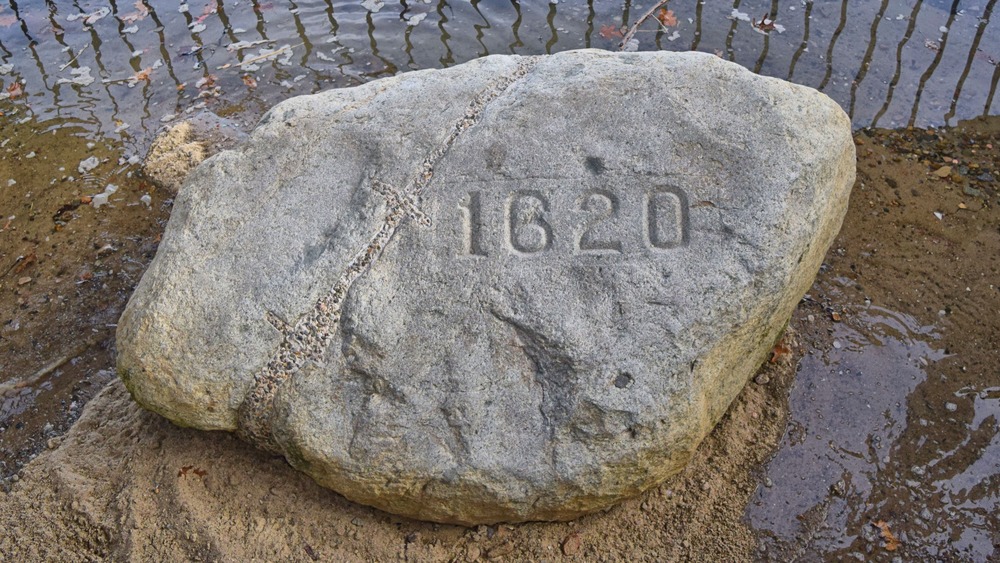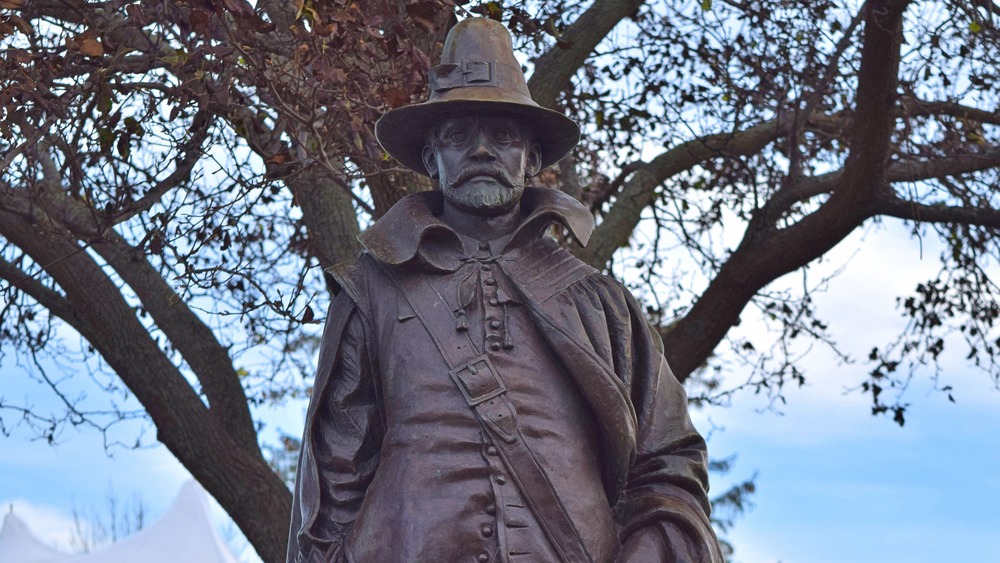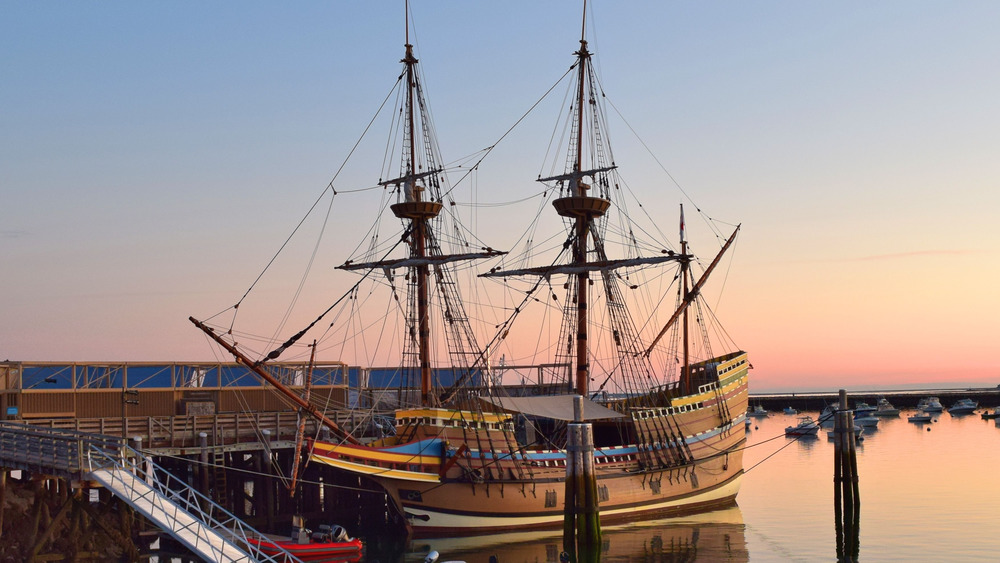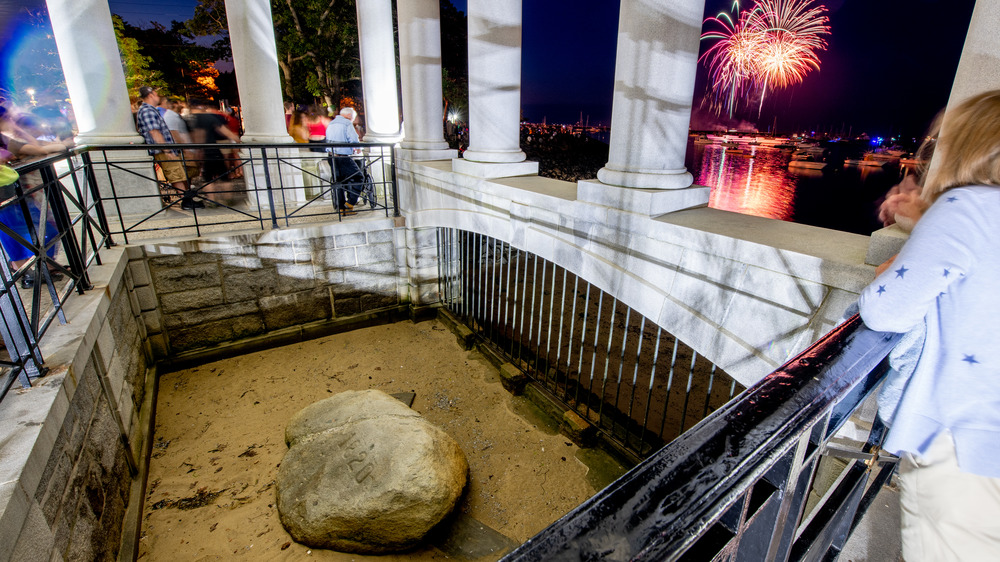The Untold Truth Of Plymouth Rock
Even if you're hazy on the details, most people who made it through elementary school in the US can relate an overview of the now-mythologized "Pilgrims land at Plymouth Rock" tale that constitutes part of the nation's early narrative. We've got those Pilgrim guys in black, with buckles on their shoes, who were completely unfun at parties and are often confused with Puritans (we'll get back to that). We've got their ship, the Mayflower, which landed on what is maybe an actual stone called Plymouth Rock. We've got lots of people dying the first winter, and Native Americans teaching them what to do to survive in a harsh, new world, their generosity repaid by stealing their land bit by bit (another story). But before that, we've got Thanksgiving, where everyone sat around a big picnic table and someone shot a turkey with a musket while posing next to a cornucopia full of squash and other root vegetables.
The truth, in this case, is actually not too, too far off from this CliffsNotes version. A group of religious English settlers self-stylized as "Saints," along with some secular passengers dubbed "Strangers," did board a ship called the Mayflower to travel across the Atlantic Ocean, as History tells us. They landed off-course in Cape Cod, north of the Virginia Company's territory between Chesapeake Bay and the mouth of the Hudson River, where they'd been given permission to land. And the first stone they stepped foot on in 1620 (apparently), Plymouth Rock, still exists to this day.
The Puritanical makings of a modern myth
As the story of Plymouth Rock and the Pilgrims commonly goes, the Pilgrims fled England to escape religious persecution and form a new Christian nation. This is vaguely accurate, but the reality of the story — and Plymouth Rock — is far overshadowed by its myth, and lives in details, not broad brushstrokes.
In 1608, the group of English separatists who wound up landing in modern-day Massachusetts had already broken away from the Church of England and migrated to the Netherlands (then Holland), as History explains. These separatists were, themselves, Puritans, a word nowadays meant to denote a rather stuffy, sour-faced sect of strict Christianity (and the root of America's "Protestant work ethic"). Puritans, by and large, adopted a "congregationalist" approach to Christianity, which meant church services were conducted in a kind of leaderless, pluralistic fashion where everyone sort of jumped on board and spoke up whenever the passion took them. This didn't settle well with the Church of England, which, per the BBC, was created by King Henry VIII when he broke away from the Catholic Church in 1534.
Some Puritans thought it was impossible to live side-by-side with Anglicans, and so they fled to a nearby, religiously tolerant country: Holland. Holland, however, was also morally and socially liberal (a big "no-no" for the separatists) and also relegated immigrants to low-paying work. Within a decade, the separatists were ready to leave.
An oceanic voyage to an underwhelming granite slab
And so, these mere 37 separatist Puritans rendezvoused with a cargo vessel, the Mayflower, back in London, and along with some 65 non-believers, set forth on the Atlantic Ocean to head off to the new world. They didn't refer to themselves as "Pilgrims," though; this name came later when renowned settler and Plymouth governor William Bradford wrote, "So they left that goodly and pleasant city which had been their resting place near twelve years; but they knew they were pilgrims... " They also didn't have any intention of creating a shining city on a hill; as Vicki Oman, associate director of group participation at Plimouth Plantation says, "The Pilgrims never really expressed that desire." The Pilgrims also weren't the first colonizers in the area, not by far. Jamestown (in what's now Virginia), as the National Parks Service tells us, had been established back in 1607.
The Pilgrims' voyage overseas can sound pretty brave, grand, or even noble. You might expect that once they landed at modern-day Cape Cod in Provincetown, Massachusetts on November 21 (per Britannica), and valiantly stepped forth onto Native lands, that their feet were touching imperious stones, similar to scaling the Cliffs of Moher in Ireland. But no. Plymouth Rock, the granite slab that the settlers originally stepped out on, is pretty underwhelming. It looks like any other rock you might ignore on a jaunt down a middling-difficulty New England hiking trail.
A rocky victim of hype and legend
As History says, visitors to New England seeking out Plymouth Rock, hoping to glimpse a vision of a legendary tale of American grandeur, more often than not just cock their head and say, "That's it?" Yes, Plymouth Rock is as plain as Puritan clothing. It may be a 600-million-year-old, glacially created hunk of coarse quartz deposited along the American coast some 20,000 years ago, per Britannica, but it's also definitely the victim of overhype regarding the founding of the US and its "forefathers" (a pre-1800s term actually used for the Pilgrims).
Present-day curiosity-seekers, as See Plymouth shows, can head to Plymouth Rock and Pilgrim Memorial State Park and find "The Rock" along the shore within a building indulgently modeled after ancient Roman architecture. If The Rock looks like it broke in half and was glued back together with sediment, that's because, well, it was.
In 1774, colonists used a team of 20 oxen to try and carry it from the coast to the town meetinghouse. It fell, broke in half, and the top was carried onward to the meetinghouse to rile up separatism. (Some took the breaking as a sign that the then-colony should separate from Great Britain.) This, by the way, as Smithsonian Magazine states, was only three years after Plymouth Rock was identified as the spot where the Pilgrims alighted, verified by 94-year old Thomas Faunce, son of one of the original pilgrims, who based his claim that it was The Rock on what his father had told him.
Chipped away at and vandalized over the years
Since then, Plymouth Rock has undergone quite a ... rocky history. Until the early 1800s, per the National Museum of American History, visitors were actually given a hammer and allowed to chip off a piece of history and take it with them. Plymouth Rock has dwindled over the years as a result, and to hasten its shrinkage even further, in 1834 the piece that was carried downtown broke again when it was being moved a few blocks north to the Pilgrim Hall Museum. Folks rushed in, started breaking pieces off, and the remnant had to be stowed behind an iron fence (which didn't help much; bits of it can be found in museums all over the country).
Meanwhile, the piece down by the shore was trimmed to fit inside its current resting place, and it was discovered that, somehow, a 400-pound chunk of it had made its way inland and was being used as a literal doorstep. In 1880, the half that had broken off in 1774 was reconnected with the half down by the shore, and "1620" was chiseled into the reunited stone.
In February 2020, as the BBC recounts, Plymouth Rock became the victim of an ignoble feat of vandalism, a full 400 years after the Pilgrims arrived. It, and other monuments around town, were slashed with red graffiti. All of them, including Plymouth Rock, have since been cleaned.




